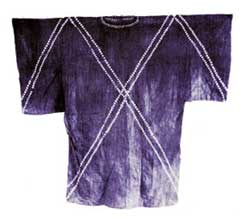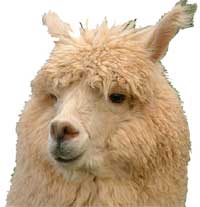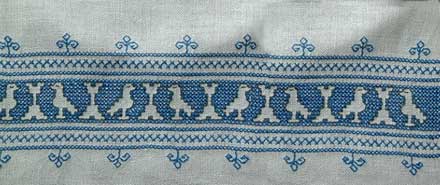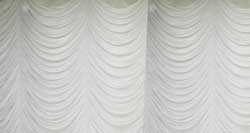ABOUT TEXTILE AND TERMS RELATING TO TEXTILE
A
Abaca
Incorrectly called Manilla hemp. Fibre commonly used in the Philippines. Fibres are tied end to end and woven without spinning. The Abaca plant belongs to the family of the banana plant and is indigenous to the Philippines. Abaca fibers are strong, durable, resistant to salt water and cheap to produce. This is a real eco-friendly fiber. See the following LINK

AbbatrE
Patterns showing depressed effects
Absorbent cotton
Fibre or cloth with natural oil or wax removed chemically. Because of absorbent nature, used for surgical purposes.
Acetate rayon
See Rayon.
Ada Canvas
See Canvas
Adatties (adatais,adathaies)
Very fine muslin of cotton imported from India at the end of the 17th century.
Adinkra
Cotton cloth produced in the Asante Kingdom, Ghana, Africa. See "Art of the Asante Kingdom"
Aeolian
See Eolienne.
Agra Gauze
Strong, transparent, gauze-like silk fabric
Airplane cloth
Originally made of linen for airplane wings. Close even texture. Since the war made of cotton in different weights and colors. Used chiefly in shirts. Weave plain.
Alacha
(alaca) "Originally a striped clothe of mixed cotton-and-silk, commonly red and white or blue and white. Gujurat Alachas usually contained a higher proportion of cotton than Bengal cloth of the same name which someone led to their being classified as calicoes.... Alachas made on the Coromandel coast were similary stripes but made entirely of cotton."
Studies in Indo-European textile history, John Irwin, P. R. Schwartz, 1966
Alapeen
Mixed wool and silk fabric used primarily for men's clothing in 18th century England.
Albatross
A light weight wool fabric with crepy surface, due to twist of yarns. Piece-dyed, usually in light colors. Launders well. A variety of albatross 44" wide is called Cripe Egypta, a trade name. Uses: dresses, negligees and infant's wear. Weave—plain. Width, 36".
A jours:
Fr. Syns.: modes (Fr.) ; fillings, lead-works (Eng.).
Fancy open stitches introduced in spaces in the pattern of both bobbin- and needle-point lace.
Aledo
See silk and cotton fabrics.
Alencon
This, the most elaborate needle-point lace which has ever been produced in France, was first made in about 1665
Algerian
Woolen fabric made in Algiers and imitated in France in the 1880's
"Algerian stripes is manufactured in alternate stripes of rough knotted cotton web, and one of a delicate gauze-like character,composed of silk. It is employed for the making of women's burnouses, in imitation of those worn by the arabs. It used to be proudeced in scarlet and cream-white." S. F. Caulfield, Blanche C. Saward The Dictionary of Needlework
Allada Cloth
Cotton cloth produced in Benin, Africa, woven on either the vertical loom or the treadle loom.

allada cloth, mid 17th c.
Allegae ( Allejae, alacha, alligeer)
Fine cloth of mixed cotton and silk imported from India by the East India Company in the XVIIth c.
Alma
Cloth of double twill weave running diagonally from left to right. Originally made in black for mourning wear.
Alpaca
1. An animal somewhat like the Angora goat, but smaller, native to South America. 2. Name of a fabric originally made of this fibre. Similar to brilliantine and mohair. Smooth, wiry with cotton warp and worsted filling (alpaca, mohair or any lustrous wool slightly twisted). Wears well, sheds dust. Uses: linings, men's summer suits and office coats, women's dresses (when in vogue). . Rayon and cotton fabric called alpaca because of its wiry nature.

Amamee
Cotton cloth, plain weave made from smooth fine yarns in Bengal
Amberty
The English East India Company established a textile factory in Patna for trading in calico and silk. Amberty or ambertee was woven there.
Amens
A kind of fabric with fancy pattern originally made in Amiens, France.
Anabasse
Wool cloth used to make blankets in the 18th century and often imported from Africa. ( "Journaux de bord et de traite de Joseph Crassous de Médeuil")
Anacoste
Wool fabric first manufactured in the Flemish town of that name. Maurepas , 1743
Anaphe Silk
Species of wild silk produced in Africa.
Angola
Light wool fabric manufactured in the XIX century. The name probably from angora. See cashmere shawls.
Annure
Drapery fabric with designs woven on a rep foundation, or a figure weave. Plain or mixed colors usually of cotton. Uses: couch covers, portieres. Weave —-Jacquard. Width, 50". 2. Silk fabric, closely woven with small pebbly pattern which suggests chain armor.
Anteng
Balinese breast cloth for women
Anterne
A fabric made of wool and silk mixed, sometimes of mohair and cotton at the end of the 17th century.
Appliqué:
A. Term used to describe a method of working lace
in which the pattern is made separately and sewn on a
net ground when completed.
B. A class of embroidery in which the pattern is cut
out of one material and sewn on (applied) a ground of
another, or on one of the same material but contrasting
in colour.
Ardasse (ardassine)
Raw silk fiber of Persia. Ardasse was used sometimes in Lyon in the early 18th century.
Aridas
Glossy silk fabric of smooth texture
Argentan Point
The needle-point lace made at Argentan is the only needle-point lace with a net ground besides Alencon which has ever been made in France. It is probable that factories at both places were established in the reign of Louis XIV. by Colbert, but its name does not appear in the ordinance.
Armazine
A kind of silk taffeta made in Lyon in the 17th and 18th century. The name is derived from the French Armoisin. It is a strong make of thick plain black corded silk, a kind of taffeta, employed for scholastic gowns.
Armore
Name derived from French "Armoires" meaning coat-of-arms. A stiff, rich looking silk, usually black. Uses: cravats, trimmings, facings for men's dress coats. Weave-fancy, called barathea. Width, 20", 36".
Arras
Lace made in the north of France in Arras
Art linen
A general term applied to a variety of plain woven linens used for embroidery. May be unbleached, ecru, white; "round thread" i.e., not calendered or smooth. Uses: chiefly needlework as lunch cloths, napkins, doilies, towels, runners; also dresses, skirts, uniforms. Weave-plain. Widths 18", 20", 27", 36", 42", 45", 48", 54". 60", 72", 81", 9°"-
Art ticking
Distinguished from regular bed ticking by its printed design. Often a floral pattern in a stripe. A tough firm cloth. Uses: mattresses and pillow covers, sometimes as cretonne. Weave—Satin or twill. Width, 36".
Artificial leather
A substitute for leather made by coating a cotton fabric with a nitro-cellulose preparation and embossing the surface to imitate leather. Various effects produced by kind of fabric foundation and the color and finish of surface. A good grade of manufactured leather is more durable than a poor grade of split leather. Sold under trade names as Pantasote, Leatkerwove, Fabrikoid, Zapon, etc. Uses: upholstering, suit cases, millinery and dress trimmings.
Artificial silk (See Rayon)
Artificial wool (See Snia-fil)
Asbestos
Fireproof fibre of mineral origin. Spun with cotton and woven. Cotton later burned away. Used for theater curtains and firemen's gloves.
Assisi embroidery
From Assissi in Italy. Embroidery in which the designs themselves are left unworked and stand out in white from a solid background worked in cross_stitches. Traditionally, Assisi embroidery was rarely executed in cross-stitch, but most often in long-armed cross-stitch.

Astrachan
Wool coating made to imitate Astrachan or Karakul fur. Foundation cloth, knitted or woven of cotton or wool. Curly pile of mohair yarn slightly twisted. May resemble the close curl of Persian lamb fur. Good quality. Wears well. Uses: coats for men, women and children, caps, muffs, trimmings. Weave—pile (may have knit back). Width, 52".
Atlas
Type of silk used in Turkey in the 16th c. Atlas was commonly used as facing on kaftans. In "Textile in America" Atlas is a silk-sattin manufactured in the East Indies.
Atu-atu
Balinese ceremonial cloth with continuous warp, blue and white stripes.
Aubusson:
(Fr. pr. o-bus-sone). Carpet or Tapestry made in Aubusson, France on hand looms. Aubusson is situated , in the upper valley of the Creuse River in central France. The first Aubusson were produced by Flemish weavers who left Flanders in the second half of the 16th c.

Aubusson tapestry, 18th c.
Austrian shade cloth
Originally made in Austria. Cotton shade cloth woven with crinkled effect in stripes, which are similar to seersucker only broader. Fancy woven stripes in color often alternate with crinkled stripes. Cotton, or mercerized cotton, silk or rayon used in combination. Natural, white or colored. Uses: window shades, bed spreads. Weave—plain 3

Axminster
Pile carpet named for town in England where first made. The manufactory was established by Thomas Whitty in 1755. In 1835 the manufactoey was moved to Wilton.
"Whitty was impressed by a large Turkish carpet he saw at Cheapside Market in London and upon his return to Axminster he used his skills as a weaver to work out how to produce a product of similar quality and after several months work he completed his first carpet on midsummer's day. His carpets were then chosen by wealthy aristocrats to have in their English country homes and town houses. Axminster Carpets were produced for the music room of the Brighton Royal Pavilion, Saltram House, Warwick Castle, Chatsworth House and in 1800 for the Sultan of Turkey. King George III and Queen Charlotte purchased Axminster carpets and also visited the factory which dominated the English carpet market between 1755 and 1835 when Samuel Rampson Whitty, the grandson of the founder was declared bankrupt following a disastrous fire seven years earlier which destroyed the weaving looms. Blackmores of Wilton, near Salisbury, bought the remaining stock and looms and extended their business to include hand-knotted carpets which were still called Axminsters." REF : Peter Long (2005). The Hidden Places of Devon. Travel Publishing Ltd
Automobile tire cloth
A variety of weaves and textures made from long staple cotton for tires. Treated with rubber and vulcanized.
Awning stripe
Duck woven with stripes (yarn dyed) for awnings and lawn umbrellas. May be used for couch covers and chair seats. Awning stripe be yarn dyed or printed.


